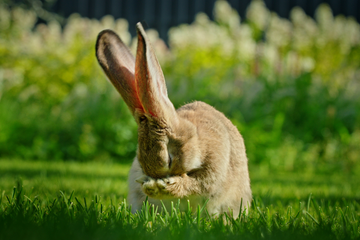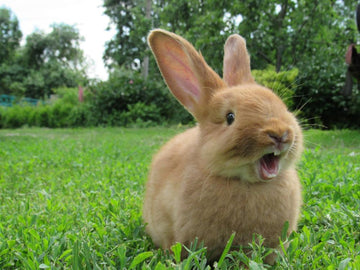Hay 101: Finding Right Hay for Small Pets
When it comes to finding the right hay for small pets, it's easy to get overwhelmed by the choices. With different cuts, textures, and benefits, how do you know what's best for your rabbit, guinea pig, or chinchilla?
Click Here For a Guide to Understanding Your Rabbits Diet.

Hay isn't just a snack—it's the foundation of your small pet's diet. The right hay can help support digestion, keep teeth healthy, and influence behavior. Whether you're a first-time owner or just looking to fine-tune your pet's nutrition, this guide will walk you through each type of hay we offer at Rabbit Hole Hay—and help you choose wisely.
Understanding Hay and Your Pet's Health
Hay does more than fill your pet's belly. It keeps their digestive system moving and helps wear down constantly growing teeth. Your pet could face serious health issues without the right kind of hay.
But not all hay is created equal. Each type has different levels of fiber, protein, and calcium; your pet's age, size, and health needs will play a big role in what kind they should eat. It’s not a one-size-fits-all situation.
Alfalfa Hay
Alfalfa Hay is best for baby rabbits younger than 7 months, guinea pigs under 6 months, and chinchillas younger than 1 year. It's packed with calcium and protein, which growing animals need to build strong bones and muscles.
What makes Alfalfa unique is that it's not actually a grass hay—it's a legume. Its stalks are thicker and coarser, with lots of small leaves that your young pet will love to nibble. But because it's so rich, it's not suitable as a daily staple for adults.
You can still offer it as a treat to mature pets, but it should be limited. Transitioning from Alfalfa to grass hay is essential once your pet reaches the right age. The switch can be tricky, especially if your pet has developed a strong preference for Alfalfa's richness. If that happens, try mixing in the new hay slowly and talk with your vet for extra guidance.
Timothy Hay Texture Names Explained
We used to label our Timothy Hay by the cut—First, Second, and Third—but found that these labels didn't tell the whole story. Instead, we now name our Timothy Hay based on how it looks and feels: Coarse, Medium, and Soft.
This makes it easier to choose the right hay based on your pet's needs. The terms "coarse" or "soft" actually describe how your pet will experience the hay—and that's what matters.
Coarse Timothy Hay
Coarse Timothy Hay is packed with thick stems, leafy pieces, and long seed heads. It typically comes from the first harvest of the season, which tends to grow more fibrous and rigid.
This hay is perfect for supporting your pet's dental health. All that chewing helps file down their teeth, preventing painful dental issues. Coarse Timothy Hay also provides long-strand fiber, which plays a huge role in healthy digestion.
If you've got a young adult pet or one that tends to inhale their food, Coarse Timothy can help slow them down while offering plenty of health benefits.
Medium Timothy Hay
Medium Timothy Hay offers a more balanced texture. It includes thinner stems, short seed heads, and broader leaves, making it easier to chew than the Coarse variety.
This grade usually comes from the second harvest, when growing conditions create a softer, leafier hay. It's a favorite for adult pets who want something easier on the teeth but still nutritious and full of fiber.
If your pet is aging or has dental sensitivities, Medium Timothy is often the sweet spot. It's still coarse enough to aid digestion and tooth wear but soft enough to chew easily.
Soft Timothy Hay
Soft Timothy Hay is made up almost entirely of soft leaves with very few stems or seed heads. It's the softest variety and often comes from a rare third or especially gentle second harvest.
Because third cuts depend on specific weather conditions—warm springs and dry falls—they can be hard to come by. Luckily, our farmers grow at high elevations, allowing us to produce hay that mimics the softness of a third cut more consistently.
Soft Timothy Hay is ideal for pets with dental issues or picky eaters who reject tougher strands. It provides essential nutrients and fiber, but since it lacks coarseness, it should be paired with tougher hay or chew toys to maintain dental health.
Finding Right Hay for Small Pets
How do you find the right hay for small pets? Start with their age and health. A baby rabbit or guinea pig needs nutrient-dense hay like Alfalfa. Adults should primarily eat grass hay like Timothy or Orchard Grass.
If your pet has a sensitive stomach, allergies, or dental issues, you may need to experiment a little to find the right match. Orchard Grass and Mountain Grass can be great alternatives if Timothy Hay doesn't agree with them.
Texture plays a big role, too. Some pets prefer crunchy, stem-filled hay, while others gravitate toward softer leaves. Observation is key—watch what your pet prefers and adjust as needed.

Coarse Orchard Grass
Coarse Orchard Grass offers high fiber and low protein. It has a texture similar to Coarse Timothy Hay, with sturdy stems and seed heads that support dental health through natural chewing behavior.
For households where someone is allergic to Timothy Hay, Orchard Grass makes a fantastic alternative. It's just as beneficial for digestion and dental health, and many pets transition to it easily.
Soft Orchard Grass
Soft Orchard Grass is the gentlest hay option we offer. With its long blades, minimal seed heads, and fewer stalks, it's ideal for pets who need a softer chew or who are picky about texture.
It has all the fiber your pet needs, but like Soft Timothy Hay, it should be combined with coarser hay to fully support dental health. Think of it as part of a balanced hay "salad" that covers all your bases.
Mountain Grass
Mountain Grass is a bit of a wildcard. It grows wild in high-elevation meadows and offers a natural blend of grass varieties.
The hay harvested from these fields has a range of textures and colors. It's full of fine, coarse leaves and is low in stems. It provides plenty of fiber for healthy digestion and is a great option for variety and enrichment.
Oat Hay
Oat Hay stands apart from the rest. Unlike Timothy or Orchard, it's a grain hay, not a grass. Despite its golden color—which comes from sun exposure—it retains its nutrients.
This hay has long, thick stems, broad leaves, and plump seed heads. The coarse texture encourages natural chewing behavior, helping dental and digestive health. Many small pets love its slightly sweet flavor from the maturing seed heads.
How Much Hay Should You Feed?
When it comes to feeding, hay isn't optional—it's the main event. For rabbits 7 months and older and guinea pigs older than 6 months, hay should make up about 80% of their daily diet. Chinchillas over one year old need slightly less, but still a hefty amount—roughly 75% of their total intake.

The rest of their diet can include fresh greens, pellets, and occasional treats. But hay is the all-day buffet that keeps their systems moving. They should always have access to it, no matter the time of day.
Think of hay as more than food—it's an activity. Rabbits and guinea pigs are natural foragers. Constant access to hay encourages physical movement, mental stimulation, and, most importantly, natural chewing behavior that prevents overgrown teeth.
Storing and Serving Hay the Right Way
Once you've found the perfect hay, how you store and serve it matters. Always keep your hay in a cool, dry place, away from sunlight and moisture. Exposure to either can cause mold or nutrient loss.
A breathable container like a hay bag or cardboard box is ideal. Avoid airtight plastic containers, as they can trap moisture. A simple paper bag inside a pantry works better than you'd think.
When it comes to serving, use a hay feeder or scatter some hay in their enclosure. If your pet tends to turn their nose up at hay, try mixing a couple of varieties. You can even sprinkle in some dried herbs or flowers to make it more exciting.
Mixing Hay for Variety and Enrichment
Finding the right hay for small pets doesn't always mean sticking to just one type. In fact, mixing hay can keep things fresh and interesting for your pet while ensuring they're getting a variety of textures and nutrients.
A blend of Coarse and Soft Timothy Hay, or Orchard Grass and Mountain Grass, can help support dental health while satisfying picky eaters. Oat Hay is also a great addition to the mix if you want to offer something crunchy and fun to chew.
Much like us, small pets enjoy a bit of variety. Offering multiple types of hay prevents boredom and can help you better understand your pet's preferences.
Signs Your Pet Might Need a Different Hay
Even after you've chosen the "right" hay, your pet might tell you otherwise. Watch for signs like selective eating, reduced appetite, softer stools, or overgrown teeth. These can indicate that the current hay isn't meeting their needs.
If your rabbit or guinea pig only eats the leafy parts and leaves the rest, they may be telling you they prefer softer or finer hay. On the other hand, if they chew nonstop but still have dental issues, they probably need a coarser option.
Don't be afraid to switch things up or talk to your vet about rotating in new types of hay. Being flexible is part of keeping your pet happy and healthy.
Why the Right Hay Matters Long-Term
Your pet's long-term health hinges on daily habits—and hay is at the center of that. Dental problems, digestive issues, and even behavioral changes can often be traced back to poor hay choices.
Feeding the right hay from the start helps your pet thrive, not just survive. It keeps their body functioning as it should and prevents expensive vet visits down the road. That's why it's worth taking the time to find the right type and quality of hay for your specific pet.
If you ever feel uncertain, there are great guides like this RSPCA resource on hay feeding, or this veterinary-backed overview from VCA Animal Hospitals to support your choices.
Conclusion: Let Your Pet's Needs Guide You
At the end of the day, finding the right hay for small pets comes down to watching, learning, and adapting. There's no universal rulebook—each rabbit, guinea pig, or chinchilla has their likes and needs.
Whether choosing between Coarse Timothy and Soft Orchard or exploring Mountain Grass and Oat Hay, the key is to provide hay that meets their nutritional and dental needs while keeping them interested and engaged.
Key Takeaways
Young pets need richer hay like Alfalfa, while adult pets thrive on high-fiber grass hays like Timothy or Orchard.
Coarse hay helps with dental wear, while softer hay is ideal for seniors or picky eaters—mixing them creates balance.
Keep an eye on your pet's behavior and eating habits to know when to adjust their hay or mix things up.

"Why Is My Rabbit Licking Her Own Pee?"

Rabbit Is It Low Maintenance or More Work Than You Think?

Tips to Manage Rabbit Chewing Habits










